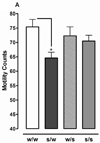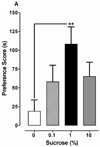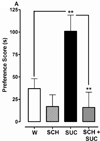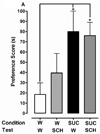Sucrose produces withdrawal and dopamine-sensitive reinforcing effects in planarians - PubMed (original) (raw)
Sucrose produces withdrawal and dopamine-sensitive reinforcing effects in planarians
Charlie Zhang et al. Physiol Behav. 2013.
Abstract
Sucrose produces physical dependence and reinforcing effects in rats. We hypothesized that similar effects could be demonstrated in planarians, the earliest animal with a centralized nervous system. We used two assays, one that quantifies withdrawal responses during drug absence as a reduction in motility and another that quantifies reinforcing effects using a conditioned place preference (CPP) design. In withdrawal experiments, planarians exposed to sucrose (1%) for 60 min and then tested in water for 5 min displayed reduced motility compared to water controls. Acute or continuous sucrose (1%) exposure did not affect motility. CPP experiments used a biased design to capitalize upon planarians' natural preference for the dark (pretest, sucrose conditioning in the light, posttest). Planarians conditioned with sucrose (1%) displayed a greater preference shift than sucrose-naïve planarians. Glucose (0.1, 1%), but not the non-digestible disaccharide lactulose (0.1, 1%), also produced a greater preference shift than water-exposed planarians. Development of sucrose-induced CPP was inhibited when sucrose (1%) conditioning was conducted in combination with dopamine receptor antagonists SCH 23390 (1 μM) or sulpiride (1 μM). These results suggest that the rewarding and reinforcing effects of sugar are highly conserved across species and that planarians offer an invertebrate model to provide insight into the pharmacological effects of sucrose and related sweeteners.
Copyright © 2013 Elsevier Inc. All rights reserved.
Figures
Fig. 1
Sucrose produces withdrawal responses following discontinuation of exposure. Planarians exposed to sucrose (S) (1%) or water (W) for 60 min were removed and tested in S (1%) or W for 5 min. Data are presented as motility counts + S.E.M. (1A) or number of head-bops + S.E.M. (1B). N = 10 planarians/group. *p < 0.05 compared to W/W group.
Fig. 1
Sucrose produces withdrawal responses following discontinuation of exposure. Planarians exposed to sucrose (S) (1%) or water (W) for 60 min were removed and tested in S (1%) or W for 5 min. Data are presented as motility counts + S.E.M. (1A) or number of head-bops + S.E.M. (1B). N = 10 planarians/group. *p < 0.05 compared to W/W group.
Fig. 2
Sucrose and glucose, but not lactulose, produce CPP. Data are presented as the mean preference score (s) + S.E.M. (difference between post-conditioning and pre-conditioning times) from planarians in which (A) sucrose (SUC) (0, 0.1, 1, 10%), (B) glucose (0, 0.1, 1%) or (C) lactulose (0, 0.1, 1%) was paired with ambient light during the conditioning phase. N = 8–10 planarians per group. **p < 0.01 compared to W in the respective experiments.
Fig. 2
Sucrose and glucose, but not lactulose, produce CPP. Data are presented as the mean preference score (s) + S.E.M. (difference between post-conditioning and pre-conditioning times) from planarians in which (A) sucrose (SUC) (0, 0.1, 1, 10%), (B) glucose (0, 0.1, 1%) or (C) lactulose (0, 0.1, 1%) was paired with ambient light during the conditioning phase. N = 8–10 planarians per group. **p < 0.01 compared to W in the respective experiments.
Fig. 2
Sucrose and glucose, but not lactulose, produce CPP. Data are presented as the mean preference score (s) + S.E.M. (difference between post-conditioning and pre-conditioning times) from planarians in which (A) sucrose (SUC) (0, 0.1, 1, 10%), (B) glucose (0, 0.1, 1%) or (C) lactulose (0, 0.1, 1%) was paired with ambient light during the conditioning phase. N = 8–10 planarians per group. **p < 0.01 compared to W in the respective experiments.
Fig. 3
Dopamine D1 or D2 receptor antagonists significantly inhibit development of CPP induced by 1% sucrose (SUC). 3A) D1 antagonist effects: CPP was determined in planarians that were conditioned with water (W), SCH, SUC, or SCH + SUC in the ambient light. 3B) D2 antagonist effects: CPP was determined in planarians that were conditioned with water (W), SUL, SUC, or SUL + SUC in the ambient light. Data are presented as the mean preference score (s) + S.E.M. (difference between post-conditioning and pre-conditioning times). N = 10 planarians per group. **p < 0.01, *p < 0.05 compared to W or SUC.
Fig. 3
Dopamine D1 or D2 receptor antagonists significantly inhibit development of CPP induced by 1% sucrose (SUC). 3A) D1 antagonist effects: CPP was determined in planarians that were conditioned with water (W), SCH, SUC, or SCH + SUC in the ambient light. 3B) D2 antagonist effects: CPP was determined in planarians that were conditioned with water (W), SUL, SUC, or SUL + SUC in the ambient light. Data are presented as the mean preference score (s) + S.E.M. (difference between post-conditioning and pre-conditioning times). N = 10 planarians per group. **p < 0.01, *p < 0.05 compared to W or SUC.
Fig. 4
Dopamine D1 or D2 receptor antagonists do not affect expression of CPP induced by 1% sucrose (SUC). 4A) D1 antagonist effects: Following a pre-test in drug-naïve planarians, conditioning with water (W) or sucrose (SUC) was conducted in the ambient light. A post-test was conducted in which planarians from both groups (W and SUC) were exposed to W or SCH. 4B) D2 antagonist effects: Experiments were conducted as described in Panel A except that SUL was used instead of SCH. Data are presented as the mean preference score (s) + S.E.M. (difference between post-conditioning and pre-conditioning times). N = 10 planarians per group. *p < 0.05 compared to respective W/W group.
Fig. 4
Dopamine D1 or D2 receptor antagonists do not affect expression of CPP induced by 1% sucrose (SUC). 4A) D1 antagonist effects: Following a pre-test in drug-naïve planarians, conditioning with water (W) or sucrose (SUC) was conducted in the ambient light. A post-test was conducted in which planarians from both groups (W and SUC) were exposed to W or SCH. 4B) D2 antagonist effects: Experiments were conducted as described in Panel A except that SUL was used instead of SCH. Data are presented as the mean preference score (s) + S.E.M. (difference between post-conditioning and pre-conditioning times). N = 10 planarians per group. *p < 0.05 compared to respective W/W group.
Similar articles
- Behavioral effects of Splenda, Equal and sucrose: Clues from planarians on sweeteners.
Ouyang K, Nayak S, Lee Y, Kim E, Wu M, Tallarida CS, Rawls SM. Ouyang K, et al. Neurosci Lett. 2017 Jan 1;636:213-217. doi: 10.1016/j.neulet.2016.11.017. Epub 2016 Nov 11. Neurosci Lett. 2017. PMID: 27845240 Free PMC article. - Operant licking for intragastric sugar infusions: Differential reinforcing actions of glucose, sucrose and fructose in mice.
Sclafani A, Ackroff K. Sclafani A, et al. Physiol Behav. 2016 Jan 1;153:115-24. doi: 10.1016/j.physbeh.2015.10.021. Epub 2015 Oct 17. Physiol Behav. 2016. PMID: 26485294 Free PMC article. - Mu Opioid Receptor Agonist DAMGO Produces Place Conditioning, Abstinence-induced Withdrawal, and Naltrexone-Dependent Locomotor Activation in Planarians.
Dziedowiec E, Nayak SU, Gruver KS, Jennings T, Tallarida CS, Rawls SM. Dziedowiec E, et al. Neuroscience. 2018 Aug 21;386:214-222. doi: 10.1016/j.neuroscience.2018.06.029. Epub 2018 Jun 27. Neuroscience. 2018. PMID: 29958944 Free PMC article. - Novelty-induced conditioned place preference, sucrose preference, and elevated plus maze behavior in adult rats after repeated exposure to methylphenidate during the preweanling period.
Crawford CA, Der-Ghazarian T, Britt CE, Varela FA, Kozanian OO. Crawford CA, et al. Behav Brain Res. 2013 Jun 1;246:29-35. doi: 10.1016/j.bbr.2013.02.031. Epub 2013 Mar 4. Behav Brain Res. 2013. PMID: 23466690 Free PMC article. - Oral, post-oral and genetic interactions in sweet appetite.
Sclafani A. Sclafani A. Physiol Behav. 2006 Nov 30;89(4):525-30. doi: 10.1016/j.physbeh.2006.03.021. Epub 2006 Apr 27. Physiol Behav. 2006. PMID: 16647093 Free PMC article. Review.
Cited by
- Guarana provides additional stimulation over caffeine alone in the planarian model.
Moustakas D, Mezzio M, Rodriguez BR, Constable MA, Mulligan ME, Voura EB. Moustakas D, et al. PLoS One. 2015 Apr 16;10(4):e0123310. doi: 10.1371/journal.pone.0123310. eCollection 2015. PLoS One. 2015. PMID: 25880065 Free PMC article. - Ethanol and cocaine: environmental place conditioning, stereotypy, and synergism in planarians.
Tallarida CS, Bires K, Avershal J, Tallarida RJ, Seo S, Rawls SM. Tallarida CS, et al. Alcohol. 2014 Sep;48(6):579-86. doi: 10.1016/j.alcohol.2014.07.006. Epub 2014 Aug 7. Alcohol. 2014. PMID: 25212751 Free PMC article. - Energy drink produces aversive effects in planarians.
Mokkarala P, Shekarabi A, Wiah S, Rawls SM. Mokkarala P, et al. Physiol Behav. 2022 Oct 15;255:113933. doi: 10.1016/j.physbeh.2022.113933. Epub 2022 Jul 26. Physiol Behav. 2022. PMID: 35905805 Free PMC article. - Predator odor produces anxiety-like behavioral phenotype in planarians that is counteracted by fluoxetine.
Cho M, Nayak SU, Jennings T, Tallarida CS, Rawls SM. Cho M, et al. Physiol Behav. 2019 Jul 1;206:181-184. doi: 10.1016/j.physbeh.2019.04.003. Epub 2019 Apr 2. Physiol Behav. 2019. PMID: 30951749 Free PMC article. - Levamisole and cocaine synergism: a prevalent adulterant enhances cocaine's action in vivo.
Tallarida CS, Egan E, Alejo GD, Raffa R, Tallarida RJ, Rawls SM. Tallarida CS, et al. Neuropharmacology. 2014 Apr;79:590-5. doi: 10.1016/j.neuropharm.2014.01.002. Epub 2014 Jan 15. Neuropharmacology. 2014. PMID: 24440755 Free PMC article.
References
- Agmo A, Galvan A, Talamantes B. Reward and reinforcement produced by drinking sucrose: two processes that may depend on different neurotransmitters. Pharmacol Biochem Behav. 1995;52:403–414. - PubMed
- Avena NM, Long KA, Hoebel BG. Sugar-dependent rats show enhanced responding for sugar after abstinence: evidence of a sugar deprivation effect. Physiol Behav. 2005;84:359–362. - PubMed
- Avena NM, Rada P, Moise N, Hoebel BG. Sucrose sham feeding on a binge schedule releases accumbens dopamine repeatedly and eliminates the acetylcholine satiety response. Neuroscience. 2006;139:813–820. - PubMed
Publication types
MeSH terms
Substances
LinkOut - more resources
Full Text Sources
Other Literature Sources
Miscellaneous



